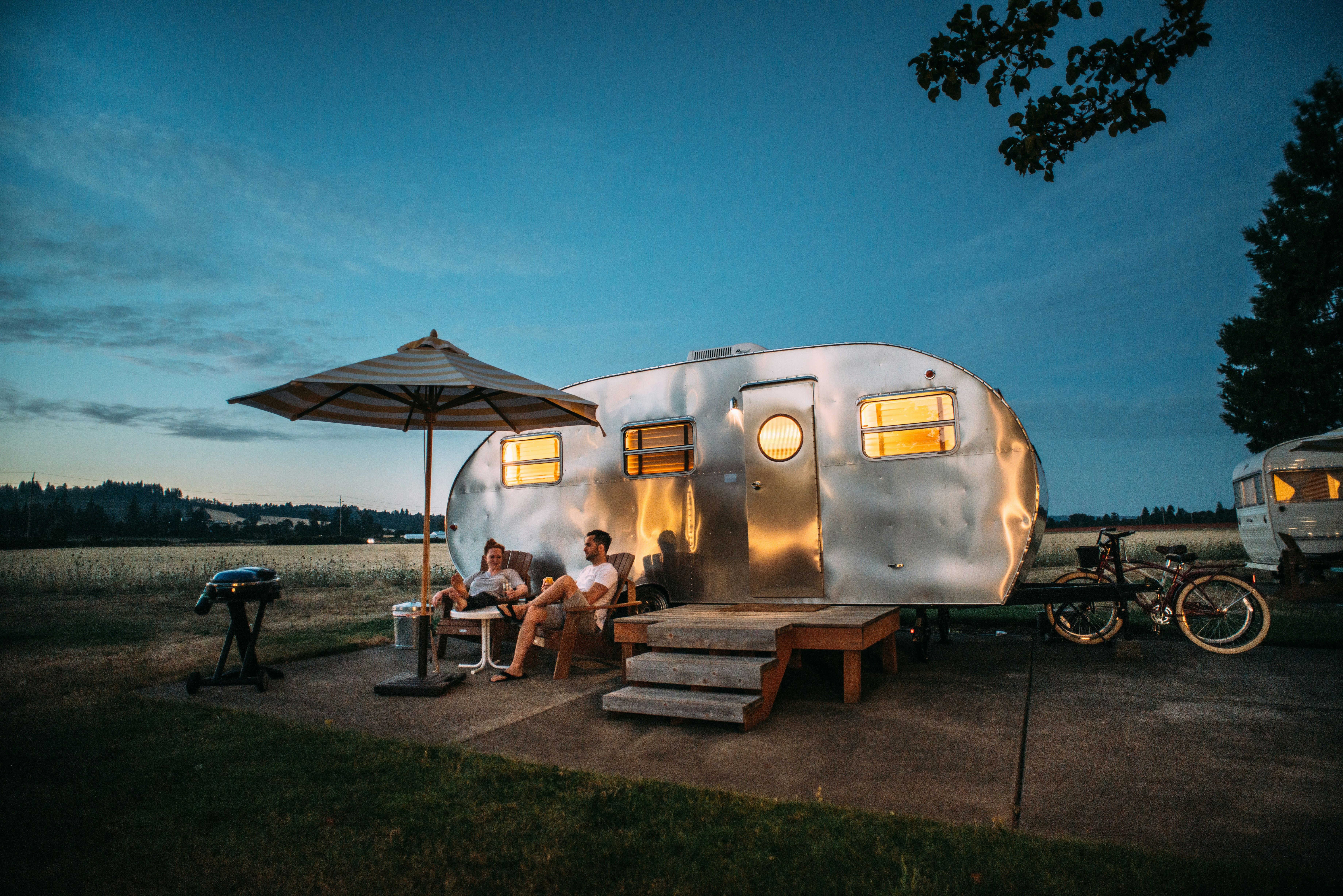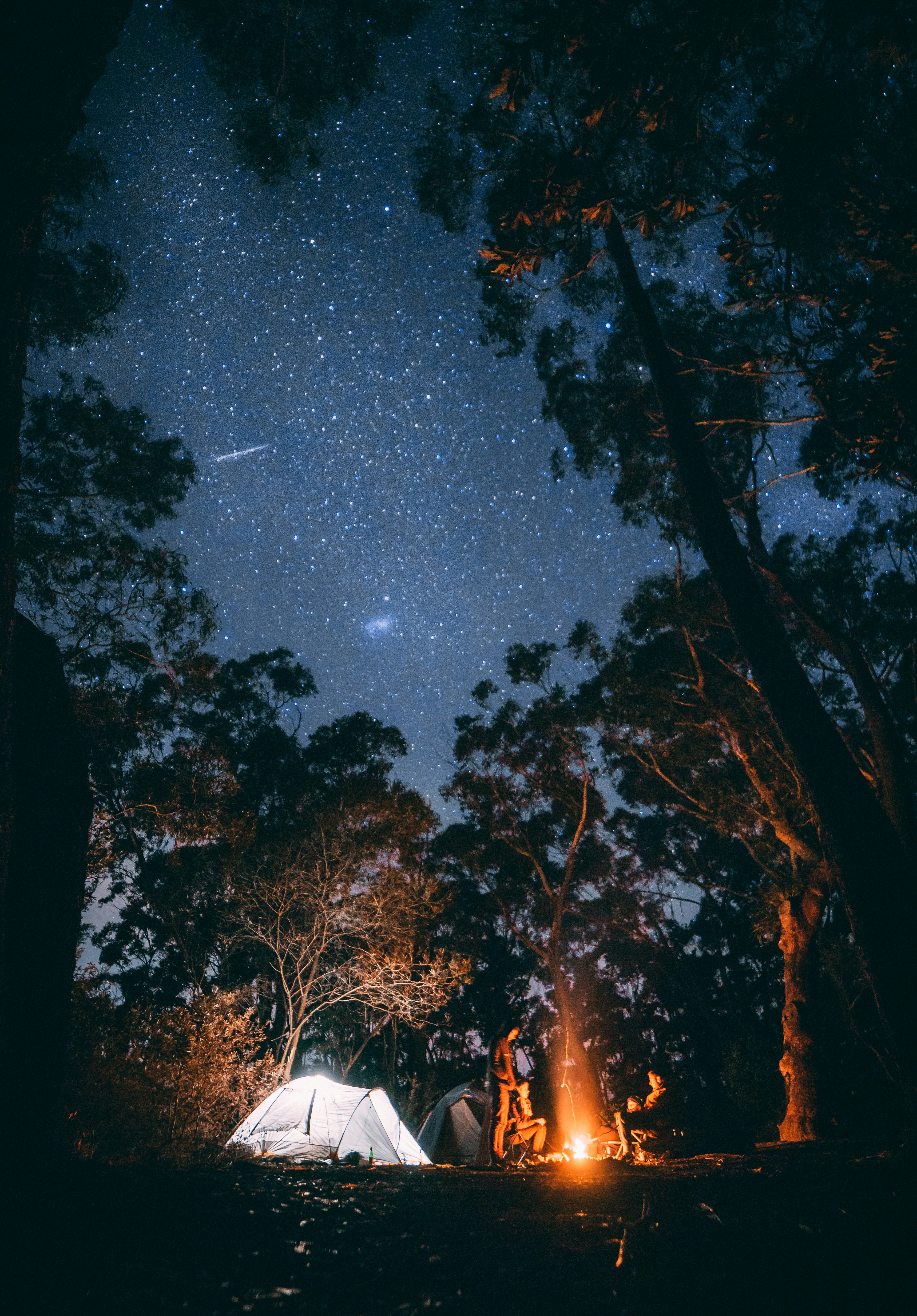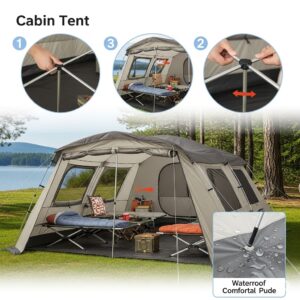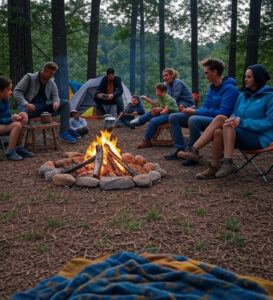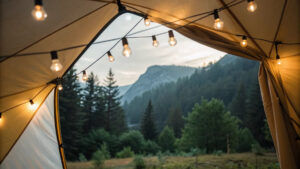The Essential Campsite Guide: What Most First-Time Campers Get Wrong

Picture this: you’ve found what looks like the perfect camping spot. The view is stunning, the ground feels level enough, and you’re ready to set up camp. But here’s what I’ve learned after countless camping trips – that perfect-looking spot might just become your worst nightmare. I’ve seen tents flood overnight and watched campers scramble away from falling branches because they didn’t know what to look for when choosing their spot.
The UK’s camping scene offers something for everyone – you’ll find everything from peaceful wild camping spots to holiday parks packed with modern comforts. But if you’re just starting out, there are some golden rules you can’t ignore. My favourite rule of thumb? Keep at least 200 feet between your tent and any water source, and for your first few trips, pick a site that’s within easy reach of home.
Trust me, I’ve made every camping mistake in the book, and that’s exactly why I’m writing this guide. I’ll share all my tried-and-tested tips for picking the perfect campsite. We’ll cover everything from spotting hidden hazards to finding that sweet spot between convenience and adventure. Ready to make your next camping trip one to remember (for all the right reasons)?
Understanding Different UK Campsite Types
Let me tell you something funny – my first camping trip was at a basic campsite where I desperately missed having a proper shower! These days, I know exactly what each type of campsite offers, and I’m excited to share what I’ve learned over the years.
Family-friendly vs basic campsites
Family campsites are like little outdoor hotels – you’ll find proper shower blocks, launderettes, and brilliant play areas for the kids [4]. Basic sites? Well, they’re more my cup of tea when I want to rough it a bit – you’ll get your water taps and waste points, but that’s about it.
Pros and Cons of Family Campsites:
Pros
- Full facilities available
- Organised activities
- Better security
Cons
- Higher costs
- More crowded
- Less wilderness feel
Wild camping regulations
Here’s something you absolutely must know – wild camping rules aren’t the same everywhere in the UK. Scotland’s pretty relaxed about it – thanks to their Land Reform Act, you can pitch up on unenclosed land [4]. But if you’re in England or Wales, you’ll need to sweet-talk the landowner first for permission [4].
Do’s and Don’ts of Wild Camping:
Do’s
- Seek landowner permission
- Camp 200 feet from water
- Leave no trace
Don’ts
- Stay more than two nights
- Light fires
- Camp near roads
Seasonal availability and booking requirements
Fancy having a semi-permanent camping spot? Seasonal pitches are brilliant for that – you can leave your setup at one site for up to seven months [4]. The best part? Some spots start at just £5.39 per night, and that includes your electricity, water, and Wi-Fi [4].
My Tried and Tested Tent Recommendations:
-
Coleman Weathermaster 8-Person Tent
-
Features: Room dividers, hinged door
-
Perfect for family camping
-
[Amazon UK Link] [Amazon USA Link]
-
-
Vango Omega 250 3-Season Tent
-
Features: Tunnel design, storm protection
-
Ideal for basic camping
-
[Amazon UK Link] [Amazon USA Link]
-
-
MSR Hubba Hubba NX 2-Person Tent
-
Features: Ultralight, freestanding
-
Great for wild camping
-
[Amazon UK Link] [Amazon USA Link]
-
Essential Pre-Arrival Campsite Research
You know what really makes my blood boil? Arriving at a campsite only to find it’s nothing like what you expected. After countless disappointing experiences early in my camping journey, I’ve learned that proper research is your best mate. Let me share my tried-and-tested research routine that’s saved me from many camping disasters.
Reading campsite reviews effectively
Here’s a little trick I’ve picked up – don’t just skim through reviews looking for star ratings. The real gold lies in spotting patterns in what campers repeatedly mention [5]. If you’re planning a family trip, look for reviews from other parents – they’ll notice things that solo campers might miss [5]. I always pay extra attention to reviews from the last few months since facilities and management can change quickly [5].
Understanding facility ratings
The UK’s star rating system for campsites is brilliant once you know how to decode it. A 3-star site isn’t just average – it actually means you’ll get modern toilet blocks and proper shower facilities [6]. Splash out on a 4 or 5-star site and you’re looking at fancy extras like fully tiled shower cubicles and posh washing facilities [6].
Star Rating Requirements:
-
3-star: One shower per gender for every 35 pitches [6]
-
4-star: At least 50% pitches with electric hook-up [6]
-
5-star: First-class toilet facilities with self-contained cubicles [6]
Checking local regulations and permissions
Right, this bit’s really important – some areas have special rules called Article 4 Directions that might stop you from camping where you fancy [7]. Plus, if a site’s open for more than 42 days straight or 60 days in total during the year, they need a proper camping licence [8]. Trust me, you don’t want to turn up and find out you can’t pitch your tent!
Do’s and Don’ts of Pre-arrival Research:
Do’s
- Check recent reviews
- Verify facility ratings
- Confirm local permissions
Don’ts
- Rely on single opinions
- Assume all sites are similar
- Book without reading rules
My Favourite Camping Apps:
-
CampMate Pro
-
Features: Offline maps, review aggregator
-
Perfect for site research
-
[Amazon UK Link] [Amazon USA Link]
-
Setting Up Your Perfect Camp Layout
Let me tell you about my biggest camping blunder – I once pitched my tent without properly checking the ground and spent the whole night sliding towards the tent door! Setting up camp isn’t rocket science, but there’s definitely a knack to it. Here’s everything I’ve learned about creating the perfect camp layout.
Tent positioning strategies
The secret to a brilliant camping experience starts with where you pop your tent. You’ll want to find a nice flat patch of ground without any nasty stones or roots poking through [9]. While those trees might look tempting for shade, I learned the hard way that camping directly underneath them is asking for trouble – think sticky sap dripping on your tent and dangerous falling branches during storms [9].
My Essential Ground Checks:
-
Give the ground a proper prod for those sneaky dips that’ll turn into puddles
-
Make sure your head end’s slightly higher than your feet – trust me, it makes a world of difference
-
Have a good sweep for old tent pegs or rubbish that might puncture your groundsheet [9]
Creating functional living spaces
A well-sorted campsite makes life so much easier. I like to think of it as setting up my outdoor living room. Pop your camping chairs and table in a spot where you can enjoy the view [10]. The trick is creating different zones – one for cooking (away from the tent, mind you), another for eating, and a cosy spot for lounging about.
My Tried-and-Tested Camping Kit:
-
Coleman Premium Camping Chair
-
Features: Padded seat, cup holder
-
Perfect for extended outdoor stays
-
[Amazon UK Link] [Amazon USA Link]
-
-
Outwell Camping Table
-
Features: Adjustable height, weatherproof
-
Ideal for dining and preparation
-
[Amazon UK Link] [Amazon USA Link]
-
Managing privacy and noise
Here’s something that’ll make you popular with your camping neighbours – keep at least six metres between you and the next pitch [11]. While camping’s brilliant for meeting new people, nobody wants to hear every word of your morning coffee chat. I always point my tent door away from other campers – it’s just good camping etiquette.
Do’s and Don’ts of Campsite Layout:
Do’s
- Position tent away from wind
- Create defined living areas
- Use natural windbreaks
Don’ts
- Camp under dead branches
- Block others’ access routes
- Make noise after 10 PM [11]
FAQs
Final Thoughts – Perfect Camp Layout
Making the Most of Your Chosen Location
Mother Nature can be your best mate when camping – if you know how to work with her. The right mix of trees and water features doesn’t just make for pretty photos; these natural elements can turn a good camping spot into a brilliant one [12].
Utilising natural features
Trees are absolute champions at making your campsite more comfortable. A good cluster of trees works like a natural shield against wind, and nothing beats their shade on a scorching summer afternoon [13]. Mind you, there’s a bit of an art to using these features properly – you want them close enough to help, but not so close they’ll cause trouble.
My Essential Weather Protection Kit:
-
Coleman Weather Shield
-
Features: UV protection, water-resistant
-
Perfect for natural shelter enhancement
-
[Amazon UK Link] [Amazon USA Link]
-
Adapting to weather conditions
The British weather loves to keep us guessing, doesn’t it? I’ve learned to spot nature’s warning signs – that peculiar smell in the air or when the birds suddenly go quiet often means weather’s about to turn [13].
Do’s and Don’ts of Weather Adaptation:
Do’s
- Check weather forecasts regularly
- Pack layers for temperature changes
- Secure loose items
Don’ts
- Stay under trees in storms
- Ignore wildlife warnings
- Leave equipment exposed
Maximising available amenities
Modern campsites have really upped their game with facilities. Would you believe one in five RV campers now work from their vehicles? That’s why decent Wi-Fi has become such a crucial feature [14].
-
Portable Power Station
-
Features: Multiple outlets, weather-resistant
-
Ideal for remote working
-
[Amazon UK Link] [Amazon USA Link]
-
-
Camping Kitchen Set
-
Features: Compact storage, weatherproof
-
Essential for facility optimisation
-
[Amazon UK Link] [Amazon USA Link]
-
FAQs
Final Thoughts – Location Optimisation
Conclusion
Final Thoughts – Essential Campsite Guide
After spending countless nights under canvas, I’ve learned that brilliant camping trips don’t just happen by chance. Whether you fancy a family-friendly site with all the mod cons or prefer roughing it at a basic pitch, picking the right spot for your comfort level makes all the difference.
Here’s something I wish someone had told me when I started – proper research is worth its weight in gold. I can’t tell you how many camping disasters I’ve dodged just by reading recent reviews, sussing out facility ratings, and checking local rules. These simple checks help you avoid the classic rookie mistakes that can turn a camping trip pear-shaped.
Setting up camp is a bit like solving a puzzle – every piece needs to fit just right. From finding that perfect level spot for your tent to creating your home-away-from-home setup, it’s all in the details. Mother Nature can be your best mate if you know her tricks. Those trees aren’t just pretty to look at; they’ll shield you from wind and sun. Just remember to keep a sensible distance from water sources – close enough for convenience but far enough for safety.
Look, camping might throw you a few curveballs, but that’s half the fun! My advice? Start with the easier, well-equipped sites before you venture into the wild unknown. Each camping trip teaches you something new, and before you know it, you’ll be sharing your own camping wisdom with wide-eyed beginners.
FAQs
Q1. What essential gear do I need for my first camping trip? For your first camping trip, focus on the basics: a tent, sleeping bags, sleeping pads or air mattresses, a camping stove, cookware, and lighting such as headlamps or lanterns. Don’t forget essentials like a first aid kit, plenty of water, and appropriate clothing for the weather.
Q2. How can I ensure a comfortable night’s sleep while camping? To sleep comfortably, invest in a good quality sleeping bag suitable for the expected temperatures and a sleeping pad or air mattress for insulation from the ground. Choose a flat area for your tent, and consider bringing pillows from home for added comfort.
Q3. What’s the best way to choose a campsite? When selecting a campsite, look for a flat, level area away from potential hazards like dead trees or low-lying areas that could flood. Ensure you’re at least 200 feet from water sources, and check local regulations regarding campsite selection and fire restrictions.
Q4. How do I prepare meals while camping? For beginners, start with simple meals that are easy to prepare. Bring a camping stove for cooking, and consider pre-preparing some meals at home. Don’t forget essentials like a cooler for perishables, cooking utensils, and cleaning supplies for washing up.
Q5. What safety precautions should I take when camping? Always inform someone of your camping plans and expected return date. Bring a first aid kit and know basic first aid. Be aware of local wildlife and store food properly to avoid attracting animals. Check weather forecasts and be prepared for changing conditions. Familiarise yourself with the area and carry a map and compass or GPS device.
References
[1] – https://www.caravanclub.co.uk/uk-holidays/useful-information/how-to-book-a-site/
[2] – https://www.campingandcaravanningclub.co.uk/advice/camping-tips/wild-camping/
[3] – https://getoutside.ordnancesurvey.co.uk/guides/is-wild-camping-legal-in-england-wales/
[4] – https://www.caravanclub.co.uk/uk-holidays/uk-sites/club-campsites/seasonal-pitches/
[5] – https://crystalrockcampground.com/know-before-you-go-tips-for-deciphering-campground-ratings/
[6] – https://business.ratedtrips.com/assessment/common-quality-standards/how-are-aa-caravan-and-camping-sites-rated
[7] – https://www.cornwall.gov.uk/planning-and-building-control/planning-enforcement/temporary-pop-up-camping-sites-planning-guidance/
[8] – https://www.hipcamp.com/journal/hosting/28-day-rule-starting-a-pop-up-campsite-uk/
[9] – https://www.campingandcaravanningclub.co.uk/advice/camping-tips/pitching-your-tent/
[10] – https://www.harvesthosts.com/blog/creating-outdoor-living-area-campsite
[11] – https://www.campsites.co.uk/guides/camping-for-beginners/camping-etiquette-and-campsite-rules
[12] – https://crrhospitality.com/blog/incorporating-natural-features-in-your-campground-site-selection/
[13] – https://www.metoffice.gov.uk/weather/warnings-and-advice/seasonal-advice/travel/out-and-about/camping-in-wind-and-rain
[14] – https://ownakoa.com/2023/10/02/top-campground-amenities-that-guests-love/

